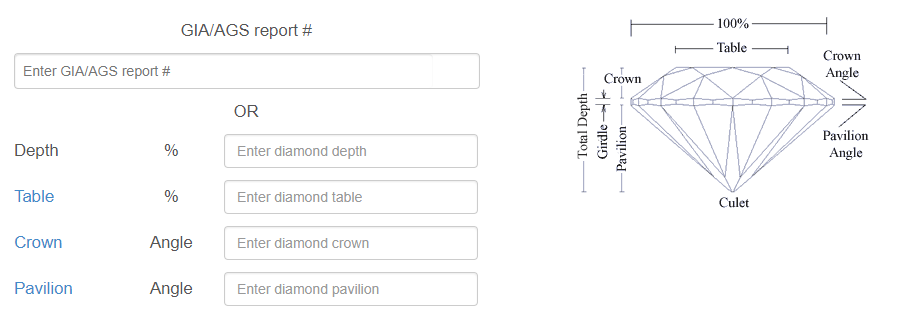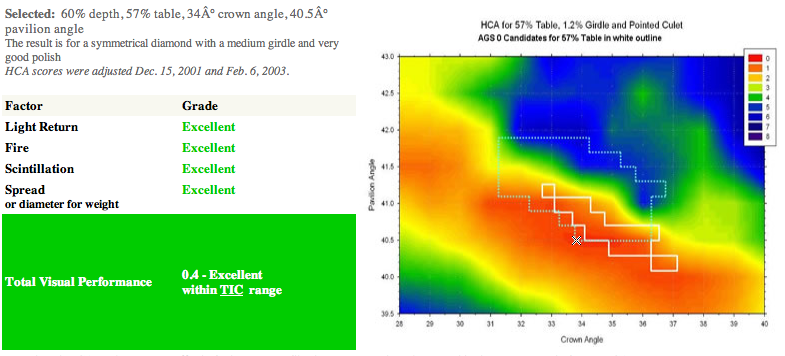There are a number of tools and programmes within the diamond trade to express the qualities of a diamond. Some of these are complex, detailed reports which require a little research to understand (such as the Sarin Report) while other are fairly straight forward.
The Holloway Cut Adviser (HCA tool) is one of the easier to use diamond analysis tools; it is user friendly and offers helpful guidance for diamond buyers.
What is the Holloway Cut Adviser?
Developed by Garry Holloway in 2001, the HCA uses a small set of data from a round brilliant diamond to produce a score that can help the user make an estimate regarding the cut quality. The tool was revolutionary in its time, allowing buyers to input the data from a number of diamonds and shortlist the best ones with ease. Since its introduction to the market nearly twenty years ago, advancements in diamond technology have rendered it a fairly rudimental form of analysis. Despite this, the simplicity of the tool makes it a good choice for diamond novices looking for a straight forward answer to the complex questions surround diamond cut quality.
It uses just five parameters to produce a score; Table %, Depth %, Crown Angle or %, Pavilion Angle or % and Culet %. It then matches these values to defined tables which have been assigned by the developer’s specified criteria for cut quality.

Image courtesy of Price Scope
Understanding the HCA Score
After analysing the data, the HCA will give a score from 0-10; the lower the score, the better quality the diamond is considered to be. It is important to note than the creator of the Holloway tool suggests it is not intended to help make a definitive purchase of a single diamond, rather it should be used to rule out diamonds of inferior quality. A score below 2 eliminates 95% of all diamonds, meaning it is effective at sifting through undesirable cuts. A score between 0-2 is considered good quality, but a buyer should then use more refined tools to truly get to grips with the quality of the diamond. Diamonds that score above 5 are to be avoided, and anything 5 a below should only be considered when budget is tight and the diamond is a good price.

Image courtesy of Price Scope
You may fall into some confusion when it comes to assessing stones that fall within the 0-2 bracket. Under the HCA grading system, diamonds within this range should be considered equally, despite variances in score (for example, .5 or 1.5). This is because variances in the proportions of a diamond results in trade-offs of certain optical characteristics such as fire or brilliance. Essentially this means that diamonds within the 0-2 range can all be considered a good cut, but a buyer must decide what they personally prefer with regards to the optical effects of the diamond before making their decision.
To help with this, the HCA tool also provides specific grades for the optical properties of Fire, Brightness, Scintillation and Spread; these grades are expressed as Excellent, Very Good, Good, Fair and Poor. Many question the reliability of these individual scores due to the lack of specific data (such as facet length and optical symmetry) which would indicate how effectively these optical properties are displayed. I would suggest that these factors are best assessed by eye, alongside any additional lab reports.
The HCA also presents a color coded chart to show where the diamond falls within the proportion charts for a GIA Excellent cut grade and an AGS Ideal cut grade. Diamonds with a score of 0-2 are considered to be within the ‘ideal; cut range and are therefore categorised as a Fiery Ideal Cut (FIC), Brilliant Ideal Cut (BIC) and Tolkowsky Ideal Cut (TIC).

Limitations of the HCA Tool
As an earlier form of diamond analysis, there are certain limitations that inhibit the HCA tool reports.
- Using Average Values: The HCA generates its results by taking the average values and proportions from the data. This does not allow for the slight deviations in the angles that a diamond is cut to and instead assumes it is perfectly symmetrical. A Sarin report is able to show the deviations between facets.
- The Measurement of Minor Facets are Not Processed: The length of the lower girdle can affect how the diamond handles light; this, among other minor facet lengths, are not taken into consideration by the Holloway Cut Adviser meaning this additional information is neglected.
- Blemishes and Inclusions: Another limitation of the tool is that it cannot account for inclusions and blemishes. These imperfections can have a big impact on how the diamond handles light and these details will not be provided in the HCA score. Likewise, it cannot measure for fluorescence and the potentially detrimental impact this can have on the beauty of a diamond.
Should I Use the HCA Tool?
The HCA tool can be useful to shoppers in the earlier stages of their search as it is a great way of quickly ruling out any dud diamonds. When it comes to diamonds that fall within the 0-2 range, further information is needed in order to make the best choice. Where possible, an Idealscope or ASET image is preferable; this advanced technology is able to process a great deal more information pertaining to the diamond and can give a much more detailed look at the cut quality.
If you wish to get and HCA Report, click here.
